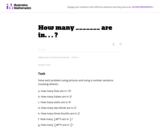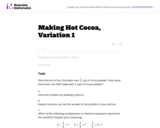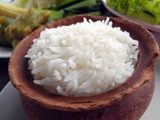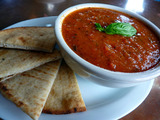
This task requires students to think about and compare fractions.
- Subject:
- Mathematics
- Material Type:
- Activity/Lab
- Provider:
- Illustrative Mathematics
- Provider Set:
- Illustrative Mathematics
- Author:
- Illustrative Mathematics
- Date Added:
- 05/01/2012

This task requires students to think about and compare fractions.

In this lesson, fraction divisions are solved by thinking how many times the divisor "fits" or "goes into" the dividend. Includes video, visual models, and word problems. [10:32]

In this lesson, learn how to divide fractions using the shortcut of reciprocal numbers which is shown in the accompanying video. [10:31] The lesson also includes practice problems and many word problems.

This video lesson teaches how to divide fractions by whole numbers (sharing divisions) using mental math.

These two fraction division tasks use the same context and ask ŇHow much in one group?Ó but require students to divide the fractions in the opposite order. Students struggle to understand which order one should divide in a fraction division context, and these two tasks give them an opportunity to think carefully about the meaning of fraction division.

The purpose of this task is to help students see the connection between aÖb and ab in a particular concrete example. The relationship between the division problem 3Ö8 and the fraction 3/8 is actually very subtle.

These problems are meant to be a progression which require more sophisticated understandings of the meaning of fractions as students progress through them.

This task addresses the division problem 4Ö1/3.

This task provides a context for performing division of a whole number by a unit fraction. This problem is a "How many groups?'' example of division.

Watch and listen to an approach to dividing fractions set to hip-hop music. This video focuses on showing why when dividing fractions you should multiply by the inverse of the second fraction.

Compare a division problem with whole numbers to a similar problem about dividing fractions in this interactive from KET. Students watch a video of a peer talking about a fraction problem that involves equal groups, with the number of groups unknown. They use Visualize It!, an interactive tool that allows students to create a visual model of each problem on the screen and then reflect on their peer's thinking and answer a quiz to test their own understanding.

Critique a peer's thinking about two division word problems, one with whole and mixed numbers and one with two fractions, in this interactive from KET. Students watch a video of a student thinking through two word problems that involve equal groups, with the group size unknown. Students respond to their peer's thinking in writing and complete interactive quizzes to demonstrate their understanding of the mathematical concepts.

This is the first of two fraction division tasks that use similar contexts to highlight the difference between the ŇNumber of Groups UnknownÓ a.k.a. ŇHow many groups?Ó (Variation 1) and ŇGroup Size UnknownÓ a.k.a. ŇHow many in each group?Ó (Variation 2) division problems.

This is the second of two fraction division tasks that use similar contexts to highlight the difference between the ŇNumber of Groups UnknownÓ a.k.a. ŇHow many groups?Ó (Variation 1) and ŇGroup Size UnknownÓ a.k.a. ŇHow many in each group?Ó (Variation 2) division problems.

Gain a basic understanding of dividing fractions by watching this easy to understand video tutorial. Additional resources are available as part of a paid subscription service. [5:12]


Fractions and Decimals
Type of Unit: Concept
Prior Knowledge
Students should be able to:
Multiply and divide whole numbers and decimals.
Multiply a fraction by a whole number.
Multiply a fraction by another fraction.
Write fractions in equivalent forms, including converting between improper fractions and mixed numbers.
Understand the meaning and structure of decimal numbers.
Lesson Flow
This unit extends students’ learning from Grade 5 about operations with fractions and decimals.
The first lesson informally introduces the idea of dividing a fraction by a fraction. Students are challenged to figure out how many times a 14-cup measuring cup must be filled to measure the ingredients in a recipe. Students use a variety of methods, including adding 14 repeatedly until the sum is the desired amount, and drawing a model. In Lesson 2, students focus on dividing a fraction by a whole number. They make a model of the fraction—an area model, bar model, number line, or some other model—and then divide the model into whole numbers of groups. Students also work without a model by looking at the inverse relationship between division and multiplication. Students explore methods for dividing a whole number by a fraction in Lesson 3, for dividing a fraction by a unit fraction in Lesson 4, and for dividing a fraction by another fraction in Lesson 6. Students examine several methods and models for solving such problems, and use models to solve similar problems.
Students apply their learning to real-world contexts in Lesson 6 as they solve word problems that require dividing and multiplying mixed numbers. Lesson 7 is a Gallery lesson in which students choose from a number of problems that reinforce their learning from the previous lessons.
Students review the standard long-division algorithm for dividing whole numbers in Lesson 8. They discuss the different ways that an answer to a whole number division problem can be expressed (as a whole number plus a remainder, as a mixed number, or as a decimal). Students then solve a series of real-world problems that require the same whole number division operation, but have different answers because of how the remainder is interpreted.
Students focus on decimal operations in Lessons 9 and 10. In Lesson 9, they review addition, subtraction, multiplication, and division with decimals. They solve decimal problems using mental math, and then work on a card sort activity in which they must match problems with diagram and solution cards. In Lesson 10, students review the algorithms for the four basic decimal operations, and use estimation or other methods to place the decimal points in products and quotients. They solve multistep word problems involving decimal operations.
In Lesson 11, students explore whether multiplication always results in a greater number and whether division always results in a smaller number. They work on a Self Check problem in which they apply what they have learned to a real-world problem. Students consolidate their learning in Lesson 12 by critiquing and improving their work on the Self Check problem from the previous lesson. The unit ends with a second set of Gallery problems that students complete over two lessons.

Students explore methods of dividing a fraction by a unit fraction.Key ConceptsIn this lesson and in Lesson 5, students explore dividing a fraction by a fraction.In this lesson, we focus on the case in which the divisor is a unit fraction. Understanding this case makes it easier to see why we can divide by a fraction by multiplying by its reciprocal. For example, finding 34÷15 means finding the number of fifths in 34. In this lesson, students will see that this is 34 × 5.Students learn and apply several methods for dividing a fraction by a unit fraction, such as 23÷14.Model 23. Change the model and the fractions in the problem to twelfths: 812÷312. Then find the number of groups of 3 twelfths in 8 twelfths. This is the same as finding 8 ÷ 3.Reason that since there are 4 fourths in 1, there must be 23 × 4 fourths in 23. This is the same as using the multiplicative inverse.Rewrite both fractions so they have a common denominator: 23÷14=812÷312. The answer is the quotient of the numerators. This is the numerical analog to modeling.Goals and Learning ObjectivesUse models and other methods to divide fractions by unit fractions

Students use models and the idea of dividing as making equal groups to divide a fraction by a whole number.SWD: Some students with disabilities will benefit from a preview of the goals in each lesson. Students can highlight the critical features or concepts in order to help them pay close attention to salient information.Key ConceptsWhen we divide a whole number by a whole number n, we can think of making n equal groups and finding the size of each group. We can think about dividing a fraction by a whole number in the same way.8 ÷ 4 = 2 When we make 4 equal groups, there are 2 wholes in each group.89÷4=29 When we make 4 equal groups, there are 2 ninths in each group.When the given fraction cannot be divided into equal groups of unit fractions, we can break each unit fraction part into smaller parts to form an equivalent fraction.34 ÷ 6 = ? 68 ÷ 6 = ? 68 ÷ 6 = 18 Students see that, in general, we can divide a fraction by a whole number by dividing the numerator by the whole number. Note that this is consistent with the “multiply by the reciprocal” method.ab÷n=a÷nb=anb=an×1b=an×b=ab×1nGoals and Learning ObjectivesUse models to divide a fraction by a whole number.Learn general methods for dividing a fraction by a whole number without using a model.

Students explore methods of dividing a fraction by a fraction.Key ConceptsStudents extend what they learned in Lesson 4 to divide a fraction by any fraction. Students are presented with two general methods for dividing fractions:Rewrite the dividend and the divisor so they have a common denominator. The answer to the original division will be the quotient of the numerators.Multiply the dividend by the reciprocal of the divisor.These two methods will work for all cases, including cases in which one or both of the numbers in the division is a fraction or whole number.Goals and Learning ObjectivesUse models and other methods to divide fractions by fractions.